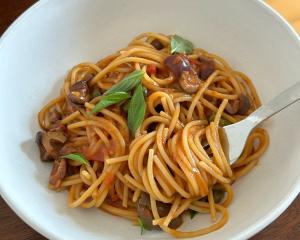Sunday lunch was traditionally a time when families would gather for a meal - usually a roast.
Mothers or grandmothers put on the roast - often a leg of hogget or mutton or a rolled roast of beef - before going to church.
In those days, roasts were always well done but remained juicy because they were roasted so slowly over three hours.
We would come home after church or Sunday School to the wonderful aromas of meat roasting and while mother finished the meal, we laid the table.
Roasts were served with roast potatoes and pumpkin, perhaps peas and carrots, and the essential gravy, sometimes, it must be admitted, made with a gravy powder and coloured with gravy browning.
However, fresh mint sauce always accompanied hogget or mutton, and we were delighted if puffy Yorkshire pudding with a crispy outside and a melting hollow inside came with roast beef.
There might be horseradish sauce too although, as children, we found that a bit too hot.
The roast was carved at the table, father sharpening the carving knife on a steel with a flourish before cutting thin slices of meat and passing plates around the table. Legs of hogget were carved in a V shape, and roast beef was carved across the grain. Carving a joint was an essential skill for a gentleman, he used to say.
Vegetables came to the table in warm dishes, and, if you were old enough, you were allowed to help yourself.
We learned to be polite and ask "Could you pass the carrots, please", or "would you like the gravy?".
There would be pudding too: a pavlova for special occasions; in winter steamed pudding or a fruit crumble with custard (the custard was my job); perhaps a rice pudding that had cooked slowly in the oven alongside the roast and had wonderful brown crusty bits at the edges; in summer, maybe fruit salad or strawberries with caster sugar and cream.
Adults might have a drink before the meal if there were guests - beer for the men and perhaps sherry for the ladies.
Wine wasn't common in those days, and we drank water with our meals.
On Monday, there would be left-over cold roast meat, and later in the week the roast might turn up again as shepherd's (mutton) or cottage (beef) pie, steaming hot and covered with mashed potato, or even in an exotically aromatic curry with raisins, served with rice.
Pork with crackling and apple sauce was not often on the menu when I was a child, and chicken only turned up at Christmas as it was rare and expensive way back then. Now chicken is the cheapest roast available.
There are different cuts these days too - legs of lamb can be boneless or butterflied, lamb chops come joined together as a rack, and other meats are available such as venison or veal and, of course, the ubiquitous chicken.
Roasting bags help keep moisture in and prevent fat splattering the oven.
Recipes have changed over the years as well. Instead of just putting the joint of meat in the oven and leaving it to cook - no-one needed recipes for that - now recipes abound for rubs and crusts, stuffings and sauces, garnishes and accompaniments.
We may think we don't have a food tradition and drool over pictures in French or Italian cookbooks of families eating together, but the Sunday roast - and afternoon tea with home baking - are part of our New Zealand tradition, even if we don't recognise it and are fast forgetting them.
The Sunday roast tradition originated in Britain where roast beef and Yorkshire pudding was the national dish - now it's said to be chicken tikka masala or fish and chips. Emigrants took the tradition around the world and it became popular not only in New Zealand and Australia, but also in Canada and the US.
Although the Sunday roast has gone out of fashion in the past few decades, there's a move to bring it back, to get families together again around the dinner table with a roast - and a glass of wine, given that wine producer Selaks sponsors a national roast day early next month. The second annual roast day is on August 7.
But it's probably getting the family around the table that's more important than reviving the actual roast itself. Make a time to sit down together over a meal, invite extended family and friends around. A roast is nice but a casserole or other dish would do as well.
And again
One of the beauties of a roast is that there are usually leftovers for another meal. Leftover roast meat can be used in many ways.
• Cold slices with pickle in sandwiches or salad.
• Chopped or minced in shepherd's or cottage pie
• Chopped in moussaka with potatoes or eggplant
• Chopped in a pasta sauce.
• Minced with veges or flavourings in ravioli.
• Chopped in curry.
• Cut up and frozen for later.
Learn more
• Visit www.selaksnzroastday.co.nz for recipes and ideas. You'll even find a vegetarian recipe for roasted vegetables and warm barley salad with balsamic dressing by Julie Biuso.
• www.beefandlamb.co.nz also has lots of recipes, tips, times and temperatures for roasting meat.












